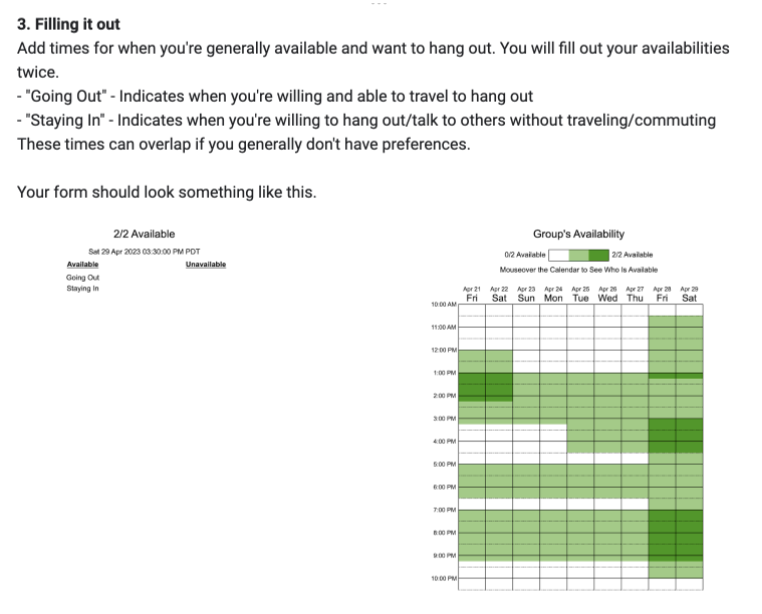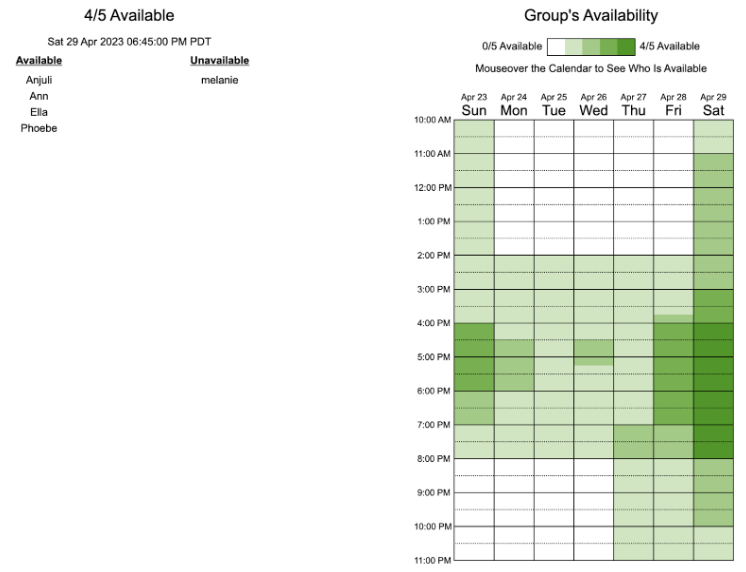Low-Fidelity Prototype
Low-Fidelity Prototype
The questions that we are most interested in exploring with our low-fidelity prototype is how receptive people would be to making plans with their friends based on our suggestions (both of times and activities). Will having our app start the planning process increase the likelihood of people following through?
In order to test this, we asked our friends to submit their availability through when2meet. We created three separate forms, one for each friend group, so that people would only be matched with their friends. This mimics the “friending” feature of our future application. Then, we manually went through the when2meets and found times where people in the same group were available. We will find activities to do in Seattle and text the groups of people a suggestion of what to do during the time that they are all available. Each member of the group will text someone else’s friend group so that the text will come from an anonymous number and not their friend. The parts that are “wizardry” is that we are manually going through people’s availability and texting them instead of automating this process. We also are manually finding events when our actual application would have a database of events. Additionally, instead of having users “friend” other users we are assuming that everyone in the same friend group would be open to meeting up with each other.
We asked people to fill out their availability like this:

This was the form people filled out.
For privacy’s sake, each person could only see their own availability. We can see everyone’s availability in order to match people, so we aggregated everyone in the group’s availability into a whentomeet so that we can decide what activities to suggest and when. This is what one of the final whentomeets looked like for one of the groups:

The goals of our wizard-of-oz session were to understand how likely people were to follow through on texts they received from our application telling them when they and their friends are all free and suggesting an activity. We prototyped our system on 2 friend groups, and found 3 different times for each group when some members of the group were available. Each group hung out once out of the three times suggested. Groups didn’t follow the exact suggestions our prototype sent them, but were inspired by the suggestions. For example, we sent one group the following suggestions: an improv show, dinner, or a craft night. The group decided to get ice cream which we felt is adjacent to getting dinner. When groups didn’t hang out, most said it was because they were busy with school and especially studying for midterms given that this was during week 5.
The findings are promising enough for us to go through with the project. Each group did use our prototype at least once, and found it helpful in making more spontaneous plans.
Elements to keep/revise:
Revise
- Add integration with Google Calendar. People found the process of adding availabilities to be difficult. Most had to pull up their calendar to fill out their availability.
- Having less notifications per person. We were sending out 3 texts per hangout and it seemed to be a bit excessive. We could possibly text once in advance (1-3 days) and then if there is no activity, we could send another followup reminder notification.
Keep
- Have a thread with all people that are free at the same time. By creating a group chat where we started the conversation, it seemed easier for people to engage with each other. Even if it was to say they were no longer available.
- Offer multiple suggestions, each varying from each other. It seems our users appreciated the ideas. In our research, and our own experiences, we often find the second hardest part of hanging out with friends (next to finding out when people are free) is figuring out what to do. It is nice to have some ideas at the start to use as plans or for inspiration.
- Notifying groups at least a day ahead of time so that they could plan their day accordingly. For groups that were going out or had plans on the weekend it was more helpful to notify them 2-3 days in advance since those things may be harder to plan for a group.
- Restricting hangouts to people all in the same friend group. In our prototype, we limited our participants to people in a friend group, who we assumed would all be friends with each other and willing to hang out. Depending on the event or group size, people would not want to hang out in a group where they only know 1 other person